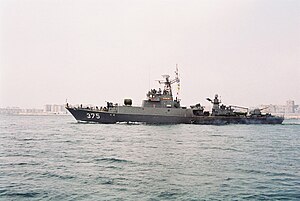This article needs additional citations for verification. (January 2013) |
 Indonesian corvette KRI Cut Nyak Dhien
| |
| Class overview | |
|---|---|
| Name | Parchim class |
| Builders | Peene-Werft, Wolgast |
| Operators | |
| Built | 1985–1989 |
| Completed | 28 |
| Active | 14 active in Indonesia, 6 active in Russia (Baltic Fleet) |
| Retired |
|
| General characteristics | |
| Type | Anti-submarine corvette |
| Displacement | 800 tons standard, 950 tons full load |
| Length | 72 m (236 ft 3 in) |
| Beam | 9.40 m (30 ft 10 in) |
| Draught | 4.60 m (15 ft 1 in) |
| Installed power | 14,250 hp (10,630 kW) |
| Propulsion | 3 shaft M504 diesels |
| Speed | 24.7 knots (45.7 km/h) |
| Range | 2,100 nmi (3,900 km) at 14 knots (26 km/h; 16 mph) |
| Complement | 80 |
| Sensors and processing systems |
|
| Armament | |
The Parchim-class corvette, Soviet designation Project 1331M, was developed for the East German Navy in the late 1970s, and built by the Wolgast Peene-Werft. The ships were designed for coastal anti-submarine warfare. In case of an all-out NATO-Warsaw Pact war in Europe their prime targets would have been the small U-206 coastal submarines of the West German navy. The first ship, Wismar (now the Indonesian KRI Sutanto), was launched on 9 April 1981 in Rostock, and subsequently another 15 ships were built until 1986. To make production more economical, the Soviet Union agreed to purchase another 12 ships from Wolgaster Peenewerft built between 1986 and 1990, thereby effectively subsidising the East German shipbuilding industry.
The ships of the Soviet Navy were named Parchim II by NATO. Though useful as a coastal ASW platform, the Soviet production of the similar but far more powerful Grisha class made this purchase even more illogical for the Soviet Navy. After German re-unification, some of the former East German ships were used briefly by the unified German Navy[1] before all of them were sold to the Indonesian Navy in 1993. The Indonesian Navy extensively refurbished their Parchims, to the point where the refurbishing exceeded the cost of purchase. They are still in service, both in the Indonesian Navy and in the Russian Baltic Fleet.
- ^ Conway 1995, p.136